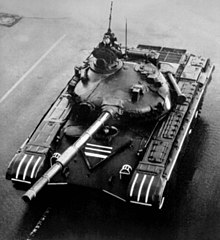Main battle tank
| Main battle tank | |
|---|---|
 German Leopard 2A5 main battle tank. | |
| Type | Tank |
| Service history | |
| In service | Cold War-now |
| Specifications | |
Main armament | Tank cannon |
A main battle tank (MBT), also called a battle tank, is a tank that is used as the most powerful combat vehicle in modern armies. They were made to replace the light, medium and heavy tanks used in World War II with just one tank. Lighter armor made it easier to put bigger guns on tanks without adding weight. Light tanks are still used in places where heavy ones cannot go.
MBT's are the main force in ground fights but get help from other combat vehicles and soldiers who travel in infantry combat vehicles. They also get help from observation or attack aircraft.[1]
History
[change | change source]Cold War
[change | change source]
Medium tanks were the earliest MBTs. MBTs started replacing medium tanks when guns on medium tanks became powerful enough to win against heavy tanks.[2] Heavy tanks could not carry armor strong enough to win against medium tanks.

The nuclear weapon threat and other anti-tank weapons in the Cold War made countries add more protection to survive in all types of combat. Weapon designers made powerful cannons to defeat the armor.[3]
The British Centurion is generally considered to have been the world’s first main battle tank, although the term was not popularised until long after it entered service. The British followed this up with the Chieftain main battle tank, which entered service in 1966. The first Soviet main battle tank was the T-64[4] and the first American MBT was the M60 Patton.[5] By the late 1970s, MBT's were manufactured by France, West Germany, Britain, India, Japan, the USSR, Sweden, Switzerland, and the United States.[6]
The Soviet Union made MBTs very quickly because it needed them for their type of war.[7] The Soviet Union improved the cannon by replacing the loader crewman with an automatic autoloader. This made the turret smaller which also makes the tank harder to see or hit[3] The Soviet Union made missiles that could be shot much farther than other ammunition.[3]
Gulf War
[change | change source]After the Cold War, American tanks quickly defeated Iraqi tanks in the Gulf War. The American MBTs were still not as good as attack helicopters at destroying Iraqi tanks.[8] Some people said that the MBTs could not stop an enemy force from attacking.[9]
Related pages
[change | change source]References
[change | change source]- ↑ Tranquiler, Roger, Modern Warfare. A French View of Counterinsurgency, trans. Daniel Lee,
Pitting a traditional combined armed force trained and equipped to defeat similar military organisations against insurgents reminds one of a pile driver attempting to crush a fly, indefatigably persisting in repeating its efforts.
- ↑ Советская Военная Энциклопедия. Под ред. Гречко А.А. - М.: Воениздат, 1976-80 гг., в 8-и томах, статья «Танк» (Soviet Military Encyclopedia)
- ↑ 3.0 3.1 3.2 Front Cover Thomas W. Zarzecki (2002). Arms diffusion: the spread of military innovations in the international system. Psychology Press. p. 212. ISBN 0-415-93514-8. Retrieved 5 April 2011.
- ↑ T-64 manual ("Танк Т-64А. Техническое описание и инструкция по эксплуатации. 1984") state T-64 as "main battle" tank, while previous T-62 and T-55 (in corresponding military manuals, like "Танк Т-62. Руководство по материальной части и эксплуатации. 1968") stated as "medium" tanks
- ↑ MIL-T-45308 state "Tank, Main Battle, 105MM Gun, M60", while MIL-T-45148 state "TANK, COMBAT, FULL-TRACKED, 90MM GUN, M48A2"
- ↑ Academic American encyclopedia, Volume 2 (1980). Academic American encyclopedia, Volume 2. Aretê Pub. Co., 1980. p. 177. ISBN 9780933880221. Retrieved 4 April 2011.
{{cite book}}: CS1 maint: numeric names: authors list (link) - ↑ David C. Isby (1988). Weapons and tactics of the Soviet Army. Jane's. ISBN 9780710603524. Retrieved 4 April 2011.
- ↑ Canadian Institute of Strategic Studies (1993). The Canadian strategic forecast. Canadian Institute of Strategic Studies. p. 73. ISBN 9780919769489. Retrieved 4 April 2011.
- ↑ Chris McNab, Hunter Keeter (2008). Tools of violence: guns, tanks and dirty bombs. Osprey Publishing. ISBN 9781846032257. Retrieved 6 April 2011.[permanent dead link]
